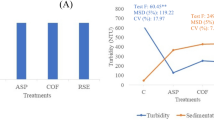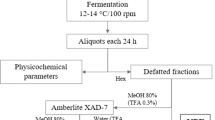Abstract
Matured coconut water (MCW) is a by-product in the coconut milk industry that is usually discarded due to its unpleasant flavor. In this study, low-alcohol coconut water (LACW) was fermented with Saccharomyces cerevisiae to improve the quality of MCW. Volatile components and nonvolatile flavor-related elements were estimated to compare the qualities of the MCW and LACW. Besides measuring the kinetic changes, the levels of fructose, glucose, sucrose and ethanol contents were also determined. The results of the organic acid assays showed that tartaric, pyruvic and succinic acids were the primary organic acids present in LACW and increased significantly with fermentation. The resulting volatile composition assay indicated that esters, alcohols and fatty acids were significantly influenced by fermentation and yeast strains. Moreover, 1,1-diphenyl-2-picrylhydrazyl (DPPH), 2,2′-azinobis-(3-ethylbenzothiazoline-6-sulfonic acid) (ABTS), cupric ion reducing antioxidant capacity and ferric reducing antioxidant power values increased significantly throughout the process, correlating with the enhancement of total phenolic content.


Similar content being viewed by others
References
Assa RR, Konan JK, Prades A, Nemlin J, Koffi E (2010) Physicochemical characteristics of kernel during fruit maturation of four coconut cultivars (Cocos nucifera L.). Afr J Biotechnol 9:2136–2144
Ayed L, Hamdi M (2015) Manufacture of a beverage from cactus pear juice using “tea fungus” fermentation. Ann Microbiol 65:2293–2299
Bardi L, Crivelli C, Marzona M (1998) Esterase activity and release of ethyl esters of medium-chain fatty acids by Saccharomyces cerevisiae during anaerobic growth. Can J Microbiol 44(12):1171
Buran TJ, Sandhu AK, Li Z, Rock CR, Yang WW, Gu L (2014) Adsorption/desorption characteristics and separation of anthocyanins and polyphenols from blueberries using macroporous adsorbent resins. J Food Eng 128:167–173
Chowdhury M, Aziz M, Uddin M (2005) Development of shelf-stable ready-to-serve green coconut water. Biotechnol 4:121–125
Coelho EM, Azevêdo LC, Corrêa LC, Lima MDS (2015) Phenolic profile, organic acids and antioxidant activity of frozen pulp and juice of the jambolan (syzygium cumini). J Food Biochem 40(2):211–219
Dashko S, Zhou N, Tinta T, Sivilotti P, Lemut MS, Trost K, et al. (2015) Yeast biodiversity approach improves the ribolla gialla wine aroma profile. J Ind Microbiol Biotechnol. https://doi.org/10.1007/s10295-015-1620-y
De Camargo AC, de Souza Vieira TMF, Regitano-d’Arce MAB, Alencar SMD, Calori-Domingues MA, Fillet Spoto MH, Canniatti-Brazaca SG (2012) Gamma irradiation of in-shell and blanched peanuts protects against mycotoxic fungi and retains their nutraceutical components during long-term storage. Int J Mol Sci 13:10935–10958
de Camargo AC, Regitanod'Arce MA, Biasoto AC, Shahidi F (2014) Low molecular weight phenolics of grape juice and winemaking byproducts: antioxidant activities and inhibition of oxidation of human low-density lipoprotein cholesterol and DNA strand breakage. J Agric Food Chem 62(50):12159
Değirmencioğlu N, Gurbuz O, Şahan Y (2016) The monitoring, via an in vitro digestion system, of the bioactive content of vegetable juice fermented with saccharomyces cerevisiae and saccharomyces boulardii. J Food Process Preserv 40(4):798–811
Dulf FV, Vodnar DC, Socaciu C (2016) Effects of solid-state fermentation with two filamentous fungi on the total phenolic contents, flavonoids, antioxidant activities and lipid fractions of plum fruit (Prunus domestica L.) by-products. Food Chem 209:27–36
Escudero-López B, Cerrillo I, Herrero-Martín G, Hornero-Méndez D, Gil-Izquierdo A, Medina S, Fernández-Pachón MS (2013) Fermented orange juice: source of higher carotenoid and flavanone contents. J Agric Food Chem 61:8773–8782
Escudero-López B, Berná G, Ángeles Ortega, Herrero-Martín G, Cerrillo I, Martín F, et al. (2015) Consumption of orange fermented beverage reduces cardiovascular risk factors in healthy mice. Food Chem Toxicol 78:78–85
Esteves VI, Lima SS, Lima DL, Duarte AC (2004) Using capillary electrophoresis for the determination of organic acids in Port wine. Anal Chim Acta 513:163–167
Gamero A, Quintilla R, Groenewald M, Alkema W, Boekhout T, Hazelwood L (2016) High-throughput screening of a large collection of non-conventional yeasts reveals their potential for aroma formation in food fermentation. Food Microbiol 60:147–159
Gaziano JM, Gaziano TA, Glynn RJ, Sesso HD, Ajani UA, Stampfer MJ, Manson JE, Hennekens CH, Buring JE (2000) Light-to-moderate alcohol consumption and mortality in the Physicians’ Health Study enrollment cohort. J Am Coll Cardiol 35:96–105
Ivanova-Petropulos V, Ricci A, Nedelkovski D, Dimovska V, Parpinello GP, Versari A (2015) Targeted analysis of bioactive phenolic compounds and antioxidant activity of Macedonian red wines. Food Chem 171:412–420
Jiang B, Zhang Z-W (2012) Comparison on phenolic compounds and antioxidant properties of cabernet sauvignon and merlot wines from four wine grape-growing regions in China. Molecules 17:8804–8821
Koksal E, Bursal E, Dikici E, Tozoglu F, Gulcin I (2011) Antioxidant activity of Melissa officinalis leaves. J Med Plants Res 5(2):217–222
Lee P-R, Chong IS-M, Yu B, Curran P, Liu S-Q (2012) Effects of sequentially inoculated Williopsis saturnus and Saccharomyces cerevisiae on volatile profiles of papaya wine. Food Res Int 45:177–183
Liang H-Y, Chen J-Y, Reeves M, Han B-Z (2013) Aromatic and sensorial profiles of young Cabernet Sauvignon wines fermented by different Chinese autochthonous Saccharomyces cerevisiae strains. Food Res Int 51:855–865
Lu Z, Fleming H, Mcfeeters R (2001) Differential glucose and fructose utilization during cucumber juice fermentation. J Food Sci Chic 66:162–166
Magalhães LM, Barreiros L, Maia MA, Reis S, Segundo MA (2012) Rapid assessment of endpoint antioxidant capacity of red wines through microchemical methods using a kinetic matching approach. Talanta 97:473–483
Markus MRP, Lieb W, Stritzke J, Siewert U, Troitzsch P, Koch M, Dörr M, Felix SB, Völzke H, Schunkert H (2015) Light to moderate alcohol consumption is associated with lower risk of aortic valve sclerosis the study of health in pomerania (SHIP). Arterioscler Thromb Vasc Biol 35:1265–1270
Morales P, Barros L, Dias MI, Santos-Buelga C, Ferreira IC, Asquieri ER, Berrios JDJ (2016) Non-fermented and fermented jabuticaba (Myrciaria cauliflora Mart.) pomaces as valuable sources of functional ingredients. Food Chem 208:220–227
Musatti A, Rollini M, Sambusiti C, Manzoni M (2015) Zymomonas mobilis: biomass production and use as a dough leavening agent. Ann Microbiol 65:1583–1589
Negi B, Dey G (2013) Effects of co-fermentation by Saccharomyces cerevisiae and Issatchenkia orientalis on sea buckthorn juice. Int J Food Sci Nutr 64:508–513
Peerajan S, Chaiyasut C, Sirilun S, Chaiyasut K, Kesika P, Sivamaruthi BS (2016) Enrichment of nutritional value of Phyllanthus emblica fruit juice using the probiotic bacterium, Lactobacillus paracasei HII01 mediated fermentation. Food Sci Technol (Campinas) 36(1):116–123
Pérez-Gregorio MR, Regueiro J, Alonso-González E, Pastrana-Castro LM, Simal-Gándara J (2011) Influence of alcoholic fermentation process on antioxidant activity and phenolic levels from mulberries ( morus nigra, l.). LWT Food Sci Technol 44(8):1793–1801
Prado FC, Lindner JDD, Inaba J, Thomaz-Soccol V, Brar SK, Soccol CR (2015) Development and evaluation of a fermented coconut water beverage with potential health benefits. J Funct Foods 12:489–497
Radin L, Pronzato C, Casareto L, Calegari L (1994) Tartaric acid in wines may be useful for preventing renal calculi: rapid determination by HPLC. J Liq Chromatogr Relat Technol 17:2231–2246
Renouf V, Claisse O, Lonvaud-Funel A (2007) Inventory and monitoring of wine microbial consortia. Appl Microbiol Biotechnol 75:149–164
Rita RD, Zanda K, Daina K, Dalija S (2011) Composition of aroma compounds in fermented apple juice: effect of apple variety, fermentation temperature and inoculated yeast concentration. Procedia Food Sci 1:1709–1716
Saerens SM, Verstrepen KJ, Laere Van SD, Voet AR, Dijck Van P, Delvaux FR, et al. (2006) The saccharomyces cerevisiae eht1 and eeb1 genes encode novel enzymes with medium-chain fatty acid ethyl ester synthesis and hydrolysis capacity. J biol chem 281(7):4446–4456
Saerens S, Verstrepen K, Thevelein J, Delvaux F (2008) Ethyl ester production during brewery fermentation: a review. Cerevisia 33:82–90
Sandhu KS, Punia S, Kaur M (2016) Effect of duration of solid state fermentation by Aspergillus awamorinakazawa on antioxidant properties of wheat cultivars. LWT Food Sci Technol 71:323–328
Sumby KM, Grbin PR, Jiranek V (2010) Microbial modulation of aromatic esters in wine: current knowledge and future prospects. Food Chem 121:1–16
Tang X, Liu J, Dong W, Li P, Li L, Lin C, et al. (2013) The cardioprotective effects of citric acid and l-malic acid on myocardial ischemia/reperfusion injury. Evid Based Complement Alternat Med 2013(3):820695
Torrens J, Urpí P, Riu-Aumatell M, Vichi S, López-Tamames E, Buxaderas S (2008) Different commercial yeast strains affecting the volatile and sensory profile of cava base wine. Int J Food Microbiol 124:48–57
Van Leeuw R, Kevers C, Pincemail J, Defraigne J-O, Dommes J (2014) Antioxidant capacity and phenolic composition of red wines from various grape varieties: specificity of Pinot Noir. J Food Compos Anal 36:40–50
Wang J-J, Tung T-H, Yin W-H, Huang C-M, Jen H-L, Wei J, Young M-S (2008) Effects of moderate alcohol consumption on inflammatory biomarkers. Acta Cardiol 63:65–72
Watawana MI, Jayawardena N, Gunawardhana CB, Waisundara VY (2016) Enhancement of the antioxidant and starch hydrolase inhibitory activities of king coconut water (Cocos nucifera var. aurantiaca) by fermentation with kombucha ‘tea fungus’. Int J Food Sci Technol 51:490–498
Wu S-C, Su Y-S, Cheng H-Y (2011) Antioxidant properties of Lactobacillus-fermented and non-fermented Graptopetalum paraguayense E. Walther at different stages of maturity. Food Chem 129:804–809
Xiong T, Li J, Liang F, Wang Y, Guan Q, Xie M (2016) Effects of salt concentration on Chinese sauerkraut fermentation. LWT Food Sci Technol 69:169–174
Yong JW, Ge L, Ng YF, Tan SN (2009) The chemical composition and biological properties of coconut (Cocos nucifera L.) water. Molecules 14:5144–5164
Acknowledgements
This research was supported by the National Natural Science Foundation of China (ID: 31640061), the Natural Science Foundation of Hainan Province of China (ID: 317002), the Hainan Key Scientific and Technological Projects of China (ID: ZDYF2016096) and the Hainan University Start-up Scientific Research Projects of China (ID: kyqd1551; kyqd1630).
Author information
Authors and Affiliations
Corresponding authors
Ethics declarations
Conflict of interest
The authors report no conflicts of interest. The authors alone are responsible for the content and writing of the paper.
Rights and permissions
About this article
Cite this article
Zhang, G., Chen, W., Chen, W. et al. Improving the quality of matured coconut (Cocos nucifera Linn.) water by low alcoholic fermentation with Saccharomyces cerevisiae: antioxidant and volatile profiles. J Food Sci Technol 55, 964–976 (2018). https://doi.org/10.1007/s13197-017-3004-y
Revised:
Accepted:
Published:
Issue Date:
DOI: https://doi.org/10.1007/s13197-017-3004-y




